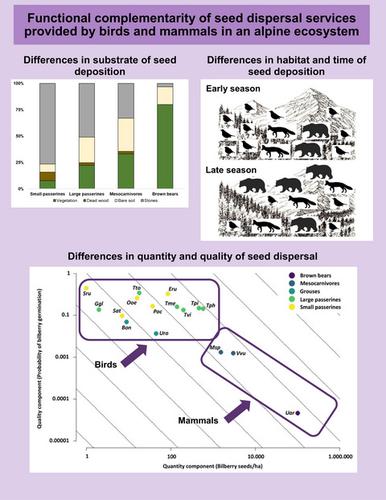Our official English website, www.x-mol.net, welcomes your feedback! (Note: you will need to create a separate account there.)
Functional complementarity of seed dispersal services provided by birds and mammals in an alpine ecosystem
Journal of Ecology ( IF 5.5 ) Pub Date : 2021-11-18 , DOI: 10.1111/1365-2745.13799 Alberto García‐Rodríguez 1 , Jörg Albrecht 2 , Nina Farwig 3 , Danuta Frydryszak 4 , Aida Parres 1 , Dana G. Schabo 3 , Nuria Selva 1
中文翻译:

高山生态系统中鸟类和哺乳动物提供的种子传播服务的功能互补性
更新日期:2022-01-13
Journal of Ecology ( IF 5.5 ) Pub Date : 2021-11-18 , DOI: 10.1111/1365-2745.13799 Alberto García‐Rodríguez 1 , Jörg Albrecht 2 , Nina Farwig 3 , Danuta Frydryszak 4 , Aida Parres 1 , Dana G. Schabo 3 , Nuria Selva 1
Affiliation

|
- Endozoochory is an important ecosystem function that, in temperate and boreal regions, is carried out mainly by birds and mammals. Due to their different quantitative and qualitative contributions to seed dispersal, these animals usually differ in their effectiveness as seed dispersers. However, there is still little information about how spatio-temporal differences in frugivory between birds and mammals may create complementarity in their seed dispersal services.
- We investigated the complementarity of seed dispersal services provided by avian and mammalian seed dispersers of bilberry Vaccinium myrtillus in an alpine ecosystem, the Tatra Mountains (Poland). We collected bird droppings and mammal scats containing bilberry seeds in coniferous forests and alpine meadows. Birds were identified by DNA barcoding techniques while mammals were visually assigned in the field. We analysed the effects of habitat, microhabitat and timing of seed dispersal on the quantitative contributions of each species to the total seed rain and conducted ex situ germination experiments to assess the quality of the seed dispersal services.
- At least 13 bird and three mammal species dispersed bilberry seeds in the Tatra Mountains. Two species of thrushes—song thrushes Turdus philomelos and fieldfares T. pilaris, brown bears Ursus arctos and red foxes Vulpes vulpes were the most effective dispersers. Quantitative and qualitative contributions to seed dispersal differed between birds and mammals. Mammals, particularly brown bears, dispersed the majority of bilberry seeds in both habitats. The total seed rain provided by birds and mammals differed according to the habitat, microhabitat and timing of seed dispersal. Birds dispersed most seeds in the middle of the fruiting season and within the forest, while seed dispersal by mammals peaked in the upper meadows and at the end of the season. Seeds defecated by birds had higher probability to germinate as their droppings contained less seeds and were defecated in more suitable microhabitats than seeds defecated by mammals.
- Synthesis. Despite differences in the quantity and quality of seed dispersal, both bird and mammal species are effective bilberry dispersers. Complementary seed dispersal by these two groups guarantees the arrival of bilberry seeds to different microhabitats suitable for germination and during the entire fruiting season, maximizing the chances of bilberry seedling recruitment.
中文翻译:

高山生态系统中鸟类和哺乳动物提供的种子传播服务的功能互补性
- 内生动物是重要的生态系统功能,在温带和北方地区,主要由鸟类和哺乳动物进行。由于它们对种子传播的定量和定性贡献不同,这些动物作为种子传播者的效力通常不同。然而,关于鸟类和哺乳动物之间食果的时空差异如何在其种子传播服务中产生互补性的信息仍然很少。
- 我们调查了高山生态系统塔特拉山脉(波兰)中越橘越橘的鸟类和哺乳动物种子传播者提供的种子传播服务的互补性。我们在针叶林和高山草甸收集了含有越橘种子的鸟粪和哺乳动物粪便。鸟类是通过 DNA 条形码技术识别的,而哺乳动物则在野外进行视觉分配。我们分析了栖息地、微生境和种子传播时间对每个物种对种子总雨量的定量贡献的影响,并进行了异地萌发实验以评估种子传播服务的质量。
- 至少有 13 种鸟类和 3 种哺乳动物在塔特拉山脉散播越橘种子。两种画眉——歌鸫Turdus philomelos和 fieldfares T. pilaris、棕熊Ursus arctos和红狐Vulpes vulpes是最有效的分散剂。鸟类和哺乳动物对种子传播的定量和定性贡献不同。哺乳动物,尤其是棕熊,将大部分越橘种子散布在这两个栖息地。鸟类和哺乳动物提供的种子雨总量因栖息地、微生境和种子传播时间而异。鸟类在结果季节中期和森林内散播大部分种子,而哺乳动物的种子散播在上层草地和季节结束时达到顶峰。与哺乳动物排便的种子相比,鸟类排便的种子发芽的可能性更高,因为它们的粪便含有较少的种子,并且在更合适的微生境中排便。
- 合成。尽管种子传播的数量和质量存在差异,但鸟类和哺乳动物都是有效的越橘传播者。这两组种子的互补传播保证了越橘种子在整个结果季节到达适合发芽的不同微生境,从而最大限度地增加越橘幼苗的机会。



























 京公网安备 11010802027423号
京公网安备 11010802027423号